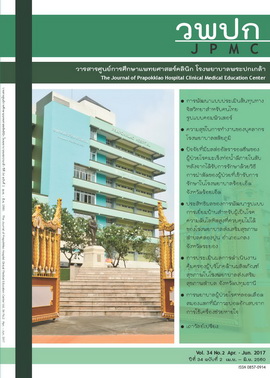ปัจจัยที่มีผลต่ออัตรารอดชีพของผู้ป่วยโรคมะเร็งท่อน้ำดีภายในตับหลังจากได้รับการรักษาด้วยวิธีการผ่าตัด ของผู้ป่วยที่เข้ารับการรักษาในโรงพยาบาลร้อยเอ็ด จังหวัดร้อยเอ็ด
Main Article Content
บทคัดย่อ
บทคัดย่อ
ที่มาของปัญหา: โรคมะเร็งท่อทางเดินน้ำดีเป็นปัญหาสำคัญทางด้านสาธารณสุขในภาคตะวันออกเฉียงเหนือของประเทศไทย ผู้ป่วยที่ได้รับการรักษาด้วยวิธีการผ่าตัดอาจจะช่วยเพิ่มระยะเวลารอดชีพได้
วัตถุประสงค์: เพื่อศึกษาปัจจัยที่มีผลต่อการรอดชีพของผู้ป่วยโรคมะเร็งท่อทางเดินน้ำดีภายในตับที่ได้รับการรักษาด้วยการผ่าตัด
วิธีการศึกษา: เป็นการศึกษาแบบ cohort โดยเก็บรวบรวมข้อมูลจากเวชระเบียนผู้ป่วยโรคมะเร็งท่อทางเดินน้ำดีภายในตับทั้งหมดที่ได้รับการรักษาด้วยการผ่าตัดที่โรงพยาบาลร้อยเอ็ด ระหว่างวันที่ 1 เดือนมกราคม พ.ศ.2553 ถึง วันที่ 31 เดือนธันวาคม พ.ศ.2557 และติดตามการมีชีวิตจนถึงวันที่ 31 เดือนมีนาคม พ.ศ. 2559 สถิติที่ใช้ในการวิเคราะห์ข้อมูลได้แก่ สถิติเชิงพรรณนา การวิเคราะห์ระยะปลอดเหตุการณ์โดยใช้โค้งปลอดเหตุการณ์ของแคปลานและไมย์เออร์ log-rank test และสถิติ cox proportional hazard model
ผลการศึกษา: จากผู้ป่วยโรคมะเร็งท่อทางเดินน้ำดีภายในตับรายใหม่จำนวน 92 ราย เป็นเพศชาย ร้อยละ 60.87 อายุเฉลี่ย 59.54 ปี (± SD = 8.63) มีระยะติดตาม 1,486 คนต่อเดือน อัตราตาย 4.8 ต่อ 100 คนต่อเดือน ผู้ป่วยหลังผ่าตัดส่วนมากมีชีวิตรอด 12.1 เดือน โดยมีอัตรารอดชีพ 3 เดือน 6 เดือน 1 ปี และ 3 ปี คือ ร้อยละ 84.8, 72.8, 51.1 และ 23.3 ตามลำดับ ปัจจัยที่มีผลต่ออัตรารอดชีพของผู้ป่วยมะเร็งท่อทางเดินน้ำดีภายในตับได้แก่ การแพร่กระจายของมะเร็ง (HRAdj. 5.3:95%CI; 3.00 - 9.34), การเป็นโรคมะเร็ง Stage IV (HRAdj. 1.3:95%CI; 1.15 - 2.65) และ Unknown stage (HRAdj. 1.4:95%CI; 1.24-2.25) ส่วนผู้ป่วยที่ได้รับการรักษาด้วยเคมีบำบัดพบมีอัตรารอดชีพมากกว่ากลุ่มที่ไม่ได้รับการรักษาด้วยเคมีบำบัด (HRAdj. 0.3:95%CI;0.26-0.69)
สรุป: การแพร่กระจายของมะเร็งและระยะของการเกิดโรคมีผลต่ออัตรารอดชีพของผู้ป่วยโรคมะเร็งท่อทางเดินน้ำดีภายในตับ ผู้ป่วยที่ได้รับการรักษาด้วยเคมีบำบัดพบมีอัตรารอดชีพมากกว่ากลุ่มที่ไม่ได้รับการรักษาด้วยเคมีบำบัด
Factors Effecting to Survival of Intrahepatic Cholangiocarcinoma after Surgical Treatment among Admitted Patients in Roi Et Hospital, Roi Et Province
Abstract
Background: Intrahepatic Cholangiocarcinoma (ICHCA) is a frequent malignancy found in the northeast of Thailand. Surgical treatment may support ICHCA patients having long time survival.
Objective: To investigate factors effecting to survival of ICHCA patients after surgical treatment.
Material and Methods: A retrospective cohort study. Data was collected from medical records of ICHCA patients who had surgical treatment at Roi Et Hospital during 1 January, 2013 to 31 December, 2015. All cases were followed up the vital status until 31 March, 2016. The data were analyzed using Kaplan-Meier method, log-rank test and Cox proportional hazard models.
Results: 92 patients were new diagnosed for ICHCA and most of them were male (60.87 percent), mean age was 59.54 years (± SD=8.63). The total follow-up times were 1,486 person-months. The mortality rate was 4.8 per 100 person-months, median survival time after surgeries was 12.1 months. The cumulative 3 month 6 months, 1 year 3 years survival rate were 84.8 percent, 72.8 percent, 51.1 percent, and 23.3 percent respectively. After adjusted data, the metastasis (HRAdj. 5.3:95%CI; 3.00- 9.34), Stage IV (HRAdj. 1.3:95%CI; 1.15- 2.65) and unknown stage (HRAdj. 1.4:95%CI; 1.24- 2.25) were the factors effected to survival of ICHCA patients. Patients who receive chemotherapy had survival rate better than non-chemotherapy therapy patients (HRAdj. 0.3:95%CI; 0.26-0.69).
Conclusion: The metastasis and stage of diseases were the important factors effecting to survival of ICHCA patients. Patients who receive chemotherapy had survival rate better than non-chemotherapy therapy patients.

